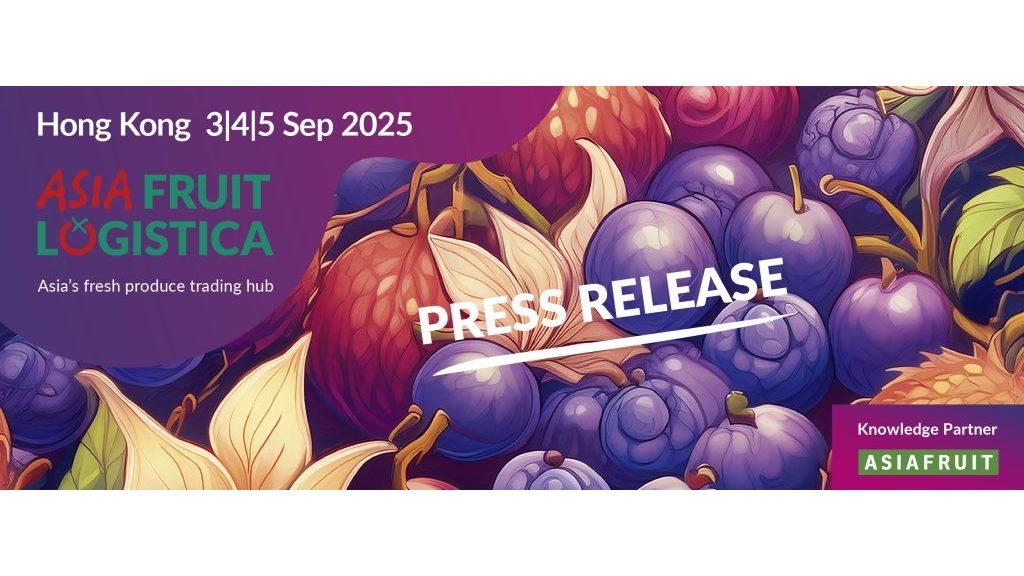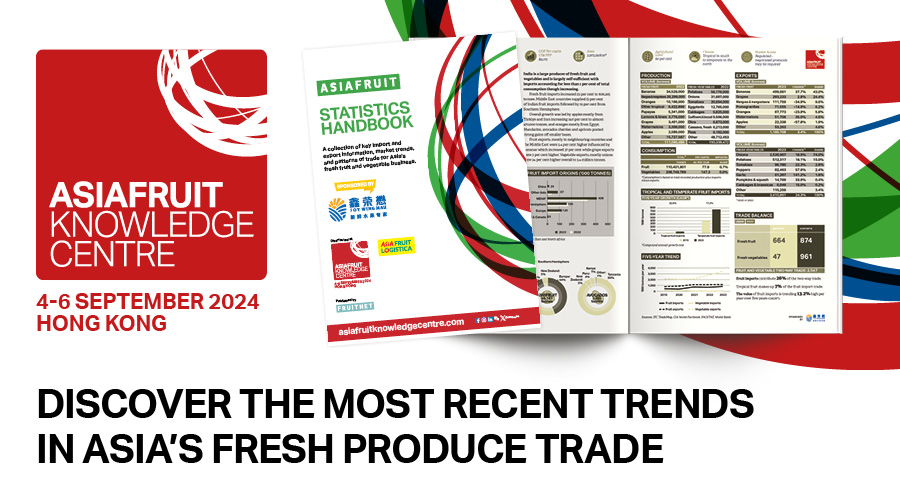You are here
Back to top[Press Release] Asiafruit Statistics Handbook Highlights Growth in Intra-Asia Trade

This content has been published as provided by its author. It has only been modified from its original version to follow Produce Report editorial guidelines and for necessary website formatting.
Sept. 26, 2024 – Asia’s total fresh fruit imports increased in 2023, driven by stronger intra-Asian trade in tropical fruits, particularly durian shipments to China.
That is one of the headline trends in Asia’s fresh produce trade highlighted in the ASIAFRUIT STATISTICS HANDBOOK 2024.
Published by Fruitnet, the annual statistical guide to Asia’s fresh produce trade was launched at ASIAFRUIT KNOWLEDGE CENTRE and ASIA FRUIT LOGISTICA on Sept. 4–6 in Hong Kong. Click here for more updates.

Asian markets imported 15.6 million metric tons of fresh fruit from all origins in 2023, marking a 4.1% increase on the previous year, according to analysis in the ASIAFRUIT STATISTICS HANDBOOK 2024.
Intra-Asian trade led the charge, increasing by 6.2% to 11 million metric tons. It accounted for more than 70% of Asia’s total fruit import trade. The intra-Asia trade is driven by demand for temperate fruit from the warm-climate Southeast Asian markets and for tropical fruit, including durians, bananas and dragon fruit, from North Asian markets.
China Drives Asia Trade
China is Asia’s largest importer and exporter of fresh fruit, and it continues to have a major influence on the overall trade landscape. Imports edged up by 1.5% to 5.9 million metric tons in 2023. This included a massive 73% increase in durian imports from Thailand and Vietnam.
China’s exports climbed 18% year on year to 3.5 million metric tons. Exports of mandarins increased by some 44%, overtaking apples as the country’s number one fresh fruit export product. Table grape exports rose 28% while apple exports declined by 3%.

Mixed Results for Global Suppliers to Asia
Global fruit imports from outside of Asia, which are mostly made up of counter-seasonal temperate fruit, declined slightly after strong growth the previous year.
Exports from Southern Africa to Asia dipped 11% to 721,632 metric tons due to a fall in orange supply during the season.
Asia’s imports from the Middle East and North Africa region grew 16%, fueled by higher volumes of Egyptian citrus and increased shipments from Turkey and Iran, particularly into India.
South American exports to Asia eased 6% to 967,689 metric tons, which included almost 400,000 metric tons of Chilean cherry exports to China and other markets. Australia and New Zealand (Australasia) saw a 2% decline in exports to 960,000 metric tons, mainly comprising kiwifruit, apples, citrus and grapes.
Imports from the United States and Canada declined 3.5% to 584,503 metric tons. Adverse weather and logistics challenges for cherries, citrus and stone fruit were key factors in the decline, alongside strong competition within Asia from local production.
Central America increased its exports by more than 20%, supplementing Asia’s supply of bananas from Southeast Asia. China is spreading its supply origins for bananas across Southeast Asian and Central American exporting countries.

Vietnam and India Record Strong Growth
Key markets in Southeast Asia saw imports decline, reflecting a downturn in apple and pear shipments from China. Thailand’s fruit imports dipped 5% to 569,836 metric tons, and Indonesia’s dropped by 8% to 611,435 metric tons, both influenced by falling apple imports. Grape imports to both markets increased, however.
Vietnam’s imports rose by 14.6% to 1.4 million metric tons, with mandarin imports soaring by some 42%, mostly sourced from China. Vietnam’s fresh fruit exports increased 24% to 1.56 million metric tons. The growth was driven by a sixfold increase in durian exports to 507,000 metric tons following the opening of the China market to Vietnamese durians.
India’s fresh fruit imports increased by 23% to 808,206 metric tons, led by apples from Turkey and Iran and oranges from Egypt.
The ASIAFRUIT STATISTICS HANDBOOK presents informed analysis, helping the fresh produce industry to make sense of production, supply and patterns of trade across 12 different Asian markets.
Access a free digital copy of the ASIAFRUIT STATISTICS HANDBOOK here.
About ASIA FRUIT LOGISTICA
ASIA FRUIT LOGISTICA is the leading international trade show for Asia’s fresh produce business. The 18th edition of ASIA FRUIT LOGISTICA takes place on Sept. 3–5, 2025, at AsiaWorld-Expo in Hong Kong. ASIAFRUIT KNOWLEDGE CENTRE is the brand-new content hub at ASIA FRUIT LOGISTICA powered by Asiafruit Magazine, ASIA FRUIT LOGISTICA’s exclusive knowledge partner. ASIAFRUIT KNOWLEDGE CENTRE is headlined by ASIAFRUIT CONGRESS, together with ASIAFRUIT BUSINESS FORUM and ASIAFRUIT SHOWCASE.
For more information on ASIA FRUIT LOGISTICA, please visit www.asiafruitlogistica.com or contact the organizing team by email at info@gp-events.com.
Images: Global Produce Events (HK) Co. Limited
















Add new comment